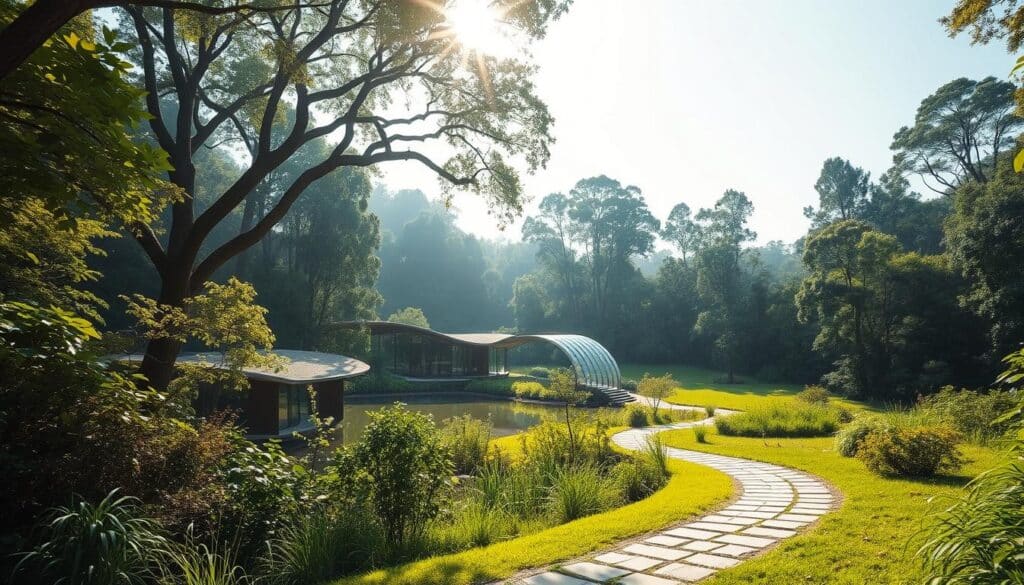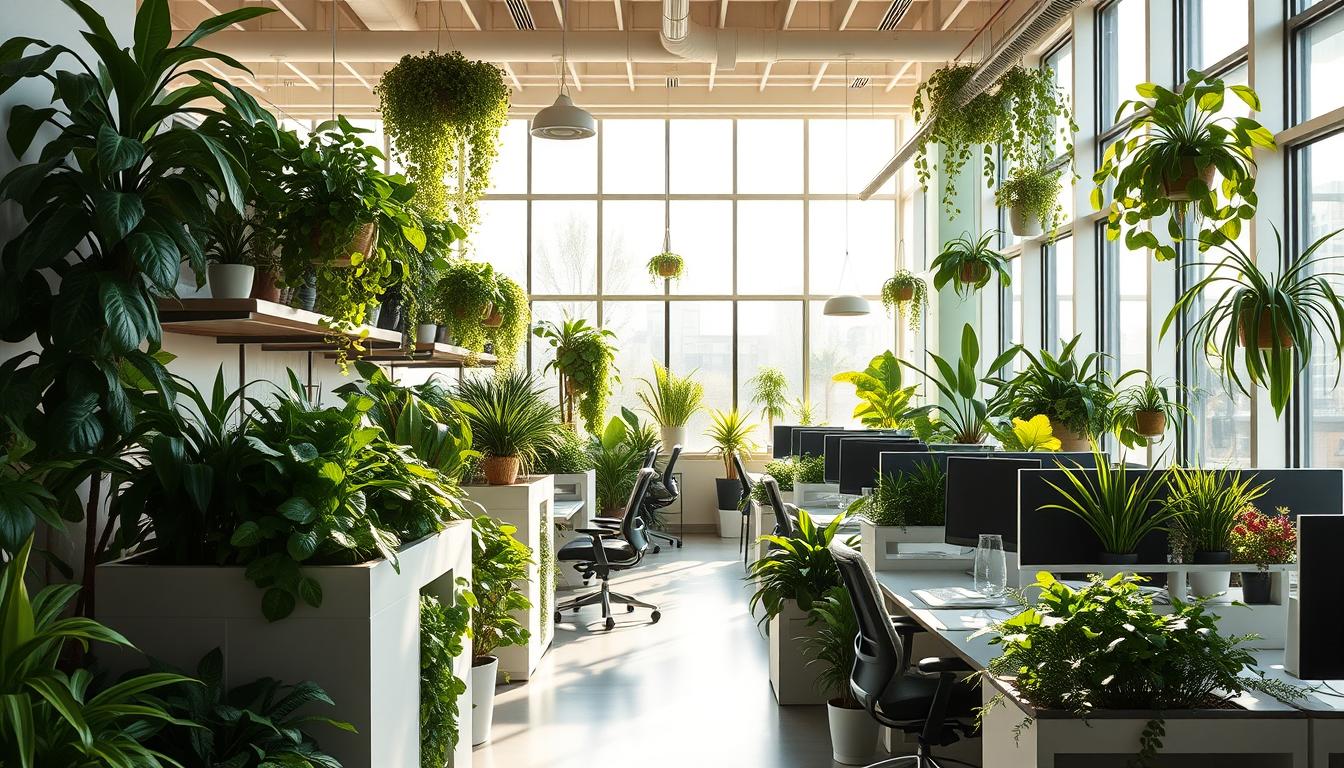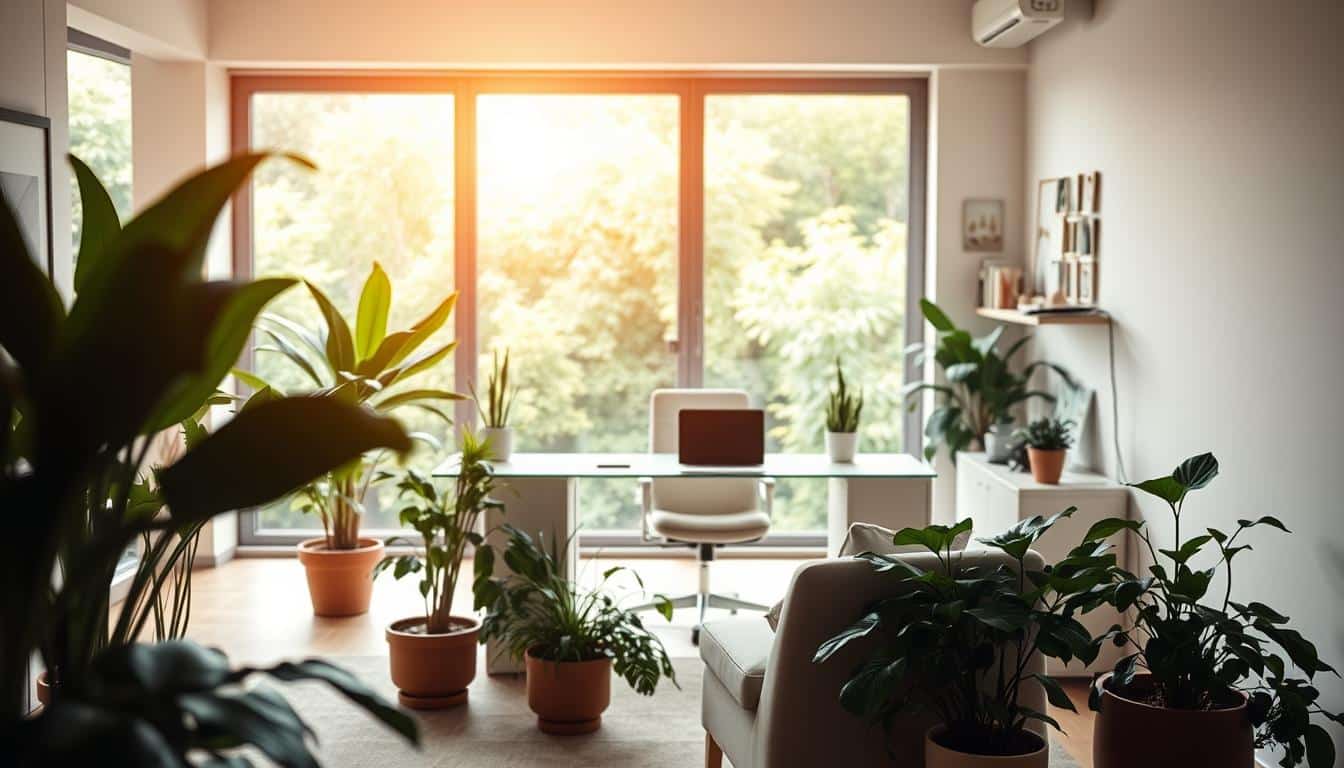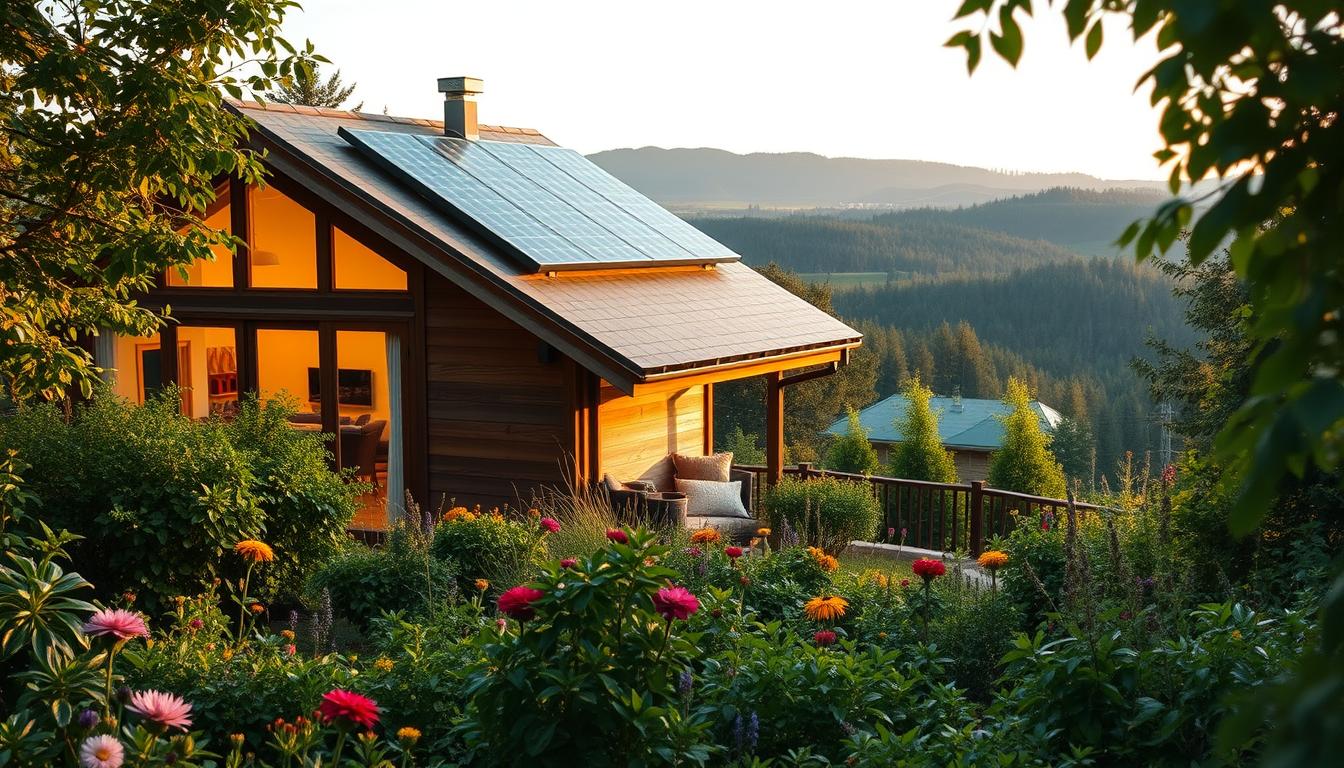Today, being eco-friendly is key. That’s where the idea of climate-responsive biophilic design comes in. It’s big in both architecture and environmental planning. This approach stresses how much nature and human-made spaces need to be linked.
It encourages the creation of buildings that blend with nature. This does more than just look good—it’s about being green, too. By diving into this design idea, we see it can change cities, make communities healthier, and solve environmental issues.
The Importance of Biophilic Design in Climate Response
Biophilic design is becoming more popular as a way to tackle climate issues. It blends nature into city settings, making places look good and work better. This method creates spaces where people and nature live in harmony. This makes buildings not just pretty, but also tough and green.
By using designs that react to the environment, cities can better handle weather changes. Biophilic design connects people with their surroundings, improving health and helping nature. It turns ordinary city parts into living systems. These systems meet the needs created by climate problems.

Understanding Climate-Responsive Biophilic Design
Humans have a natural connection to the outdoors. This idea lies at the heart of the biophilia concept. It’s not just about liking plants and animals. It’s about our need to be close to nature, which is crucial for our happiness in cities.
Defining Biophilia
The term biophilia was first used by Erich Fromm. Later, biologist E.O. Wilson made it popular. It means we have a built-in connection with other living things. Understanding biophilia shows we’re part of nature, not separate from it. Designers can use this idea to make spaces that draw us closer to nature. This helps us feel at peace, even in busy cities.
The Connection Between Nature and Urban Living
City life often cuts us off from nature, which can harm our health. Biophilia teaches us to bring nature back into cities. Things like parks, green roofs, and living walls make cities prettier. They also let us feel closer to nature, giving us clean air and calm places. By focusing on biophilic design, cities can make life better for everyone and support eco-friendly growth.
Principles of Climate-Responsive Biophilic Design
Mixing nature with architecture is key in climate-responsive biophilic design. It’s not just about looking good. This approach improves the environment, strengthens climate resilience, and boosts well-being. It helps us feel closer to nature around us.
Integrating Natural Elements into Architecture
Adding plants, water, and sunlight makes buildings and nature work better together. Here are some ways to do that:
- Utilizing living walls to improve air quality and create a vibrant atmosphere.
- Incorporating skylights and large windows for maximizing natural light intake.
- Incorporating water features that not only enhance beauty but also help regulate humidity levels.
Designing for Environmental Harmony
It’s important for buildings to match their natural settings. Focusing on biophilic design helps buildings be more self-sufficient. Here are key elements:
- Implementing passive solar design to minimize energy consumption.
- Using locally sourced materials to reduce environmental impact during construction.
- Creating green spaces that encourage biodiversity while promoting health and well-being.
Innovative Urban Applications of Biophilic Design
Cities are now using biophilic design to make living spaces that blend well with nature. Many buildings show how natural elements in architecture work well. This approach improves the look of places and makes residents and visitors healthier and happier.
Examples of Successful Biophilic Structures
Many buildings show the positive effects of biophilic design. For example, the Portland International Airport has been transformed with plants, sunlight, and natural materials. This creates a peaceful setting that connects indoor spaces with the natural world outside. Other structures might include features like living walls and rooftop gardens. These additions help wildlife and make the space better for people.
Effective Use of Green Infrastructure
Green infrastructure is key for biophilic design. Things like rain gardens, porous pavements, and green roofs help tackle city problems in a sustainable way. They manage rainwater better and increase the variety of plants and animals in cities. By adding these elements to city plans, places become not just more beautiful but also work better. They help designs succeed, bringing communities closer to nature.
Benefits of Climate-Responsive Biophilic Design
Climate-responsive biophilic design has many benefits that go beyond just looking good. It makes our cities more eco-friendly and supports sustainability. By blending nature with buildings, we create spaces that both help the environment and make life better for people.
Environmental Impact and Sustainability
Adding biophilic design to buildings can really help our planet. It makes buildings use less energy, produce less waste, and clean the air. This way, we get green spaces that help plants and animals thrive and fix some city problems.
Health and Well-Being for Inhabitants
Biophilic design is also great for our health. It can lower stress, boost mental health, and encourage us to move more. By bringing more nature into cities, people feel closer to the natural world. This connection is key for feeling good. Plus, sustainable design makes places more pleasant to live in, helping everyone feel happier and more alive.
Challenges in Implementing Biophilic Design
Biophilic design is getting more popular, but it faces several challenges. Overcoming these challenges is key for better integration with nature in our buildings and cities.
Barriers to Mainstream Adoption
The industry hasn’t fully embraced biophilic design yet. Obstacles include:
- Resistance to innovation in architectural practice.
- A lack of knowledge about biophilic benefits among clients and stakeholders.
- Architects and designers need more training in natural design integration.
- There are few rules to help sustainable design efforts.
Economic Considerations
Money matters also slow down the use of biophilic design. The costs upfront can scare off developers. Things that make it financially challenging include:
- More money needed early on for eco-friendly materials and tech.
- Doubts about whether the investment will pay off.
- Fears over experimenting with new, green design ideas.
The Role of Policy and Legislation
Making policies well can help biophilic design grow. Government rules can help blend city building and nature. Laws are key to mixing nature into our cities and buildings.
Regulations Supporting Biophilic Design
Rules for green building make using nature in architecture a must. They ask for more greenery, natural stuff, and saving energy. Prizes like tax cuts or money help push these green steps.
Case Studies from Government Initiatives
Some cities show how laws help biophilic design work well. Places with green roofs and nature spots get better and tougher. These examples show how nature-friendly laws help people and nature thrive.
Future Trends in Climate-Responsive Biophilic Design
Biophilic design trends are changing. They now focus on how architecture can fit within larger natural systems. With rising environmental issues, we need innovative buildings. These buildings should boost our well-being and help the planet. Architects using biophilic ideas will change our built environments greatly.
Shifts in Architectural Practices
Architects are now focusing more on sustainable, biophilic design. They are:
- Integrating natural elements such as greenery and light into building designs.
- Prioritizing livable spaces that enhance occupant well-being.
- Fostering community engagement through shared green areas.
This shift means buildings will better match human and natural worlds. It leads to healthier places to live.
Technological Innovations Enhancing Biophilia
Technology is key in evolving biophilic design. New tools let architects build in harmony with nature. Innovations include:
- Smart building systems that optimize natural light and ventilation.
- Biodegradable materials that lessen environmental harm.
- Augmented reality apps that show biophilic designs before they’re built.
These tech advances show how eco-friendly architecture can grow. They combine technology with nature, tackling climate issues and boosting biophilia.
Climate-Responsive Biophilic Design as a Solution
Climate-responsive biophilic design is key in tackling today’s environmental issues like climate change and urban stress. It combines architecture with nature, enhancing climate resilience and improving urban well-being. Through innovative design, cities can better handle climate change impacts while also building vibrant communities.
Using natural materials, maximizing daylight, and increasing green spaces are core strategies. These approaches strengthen our bond with nature, boosting happiness and health. Green spaces in cities show the value of sustainable development.
By applying biophilic principles, communities get involved and learn, feeling a greater connection to their surroundings. These actions support biodiversity and help cool our cities. In the end, climate-responsive biophilic design offers a holistic way to balance nature with urban life.
Real-World Case Studies of Biophilic Design
Urban projects are using biophilic design to make communities better. They help improve life quality for people living there. These efforts mix nature with city life, creating lively and green places.
Urban Regeneration Projects
The Cloud Gardener project in Manchester turned balconies into mini ecosystems. People got involved, making their areas greener and helping nature. It shows how using biophilic design can make cities more alive.
Community-Based Approaches
Communities are working together on biophilic design. They’ve made green roofs and gardens, bringing people closer to nature. These projects meet community needs and make life better, showing biophilic design at work.
Conclusion
Exploring climate-responsive biophilic design shows its key role in making cities thrive. It connects us with nature and meets human and earth needs. By focusing on our bond with nature, we can achieve sustainable architecture. This leads to cities that can face climate change well.
The importance of biophilia in architecture will grow. Using these ideas boosts health and helps the planet. As we deal with climate change, adopting biophilic design is crucial. It helps create spaces that support life and keep the environment healthy.
In closing, as we seek new and flexible design solutions, biophilia shines as a hopeful path. It encourages a sustainable future by making urban areas better for us and the earth.



